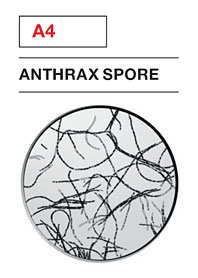
A week after September 11, envelopes containing a white powder and crudely hand-lettered notes arrived in the offices of five media companies. Then, in early October, they showed up at the offices of two United States senators (return address: 4th Grade; Greendale School; Franklin Park, New Jersey). The attacks killed five people and inaugurated a new era in fear—at a moment when no one had even begun to process the old one. The powder was anthrax [A4], an often fatal bacteriological toxin associated with grazing animals like cattle and sheep, and one of the most notorious bioweapons, if not the most effective. Gas masks started to appear in desk drawers; new mail-opening procedures were devised, and rubber gloves were issued all over New York and D.C. Weaponized and Cipro became household terms. At one point it was reported that Mohamed Atta and the 9/11 terrorists had contemplated buying a crop duster, even visiting a Florida airport and talking to crop-dusting pilots about their work. After that, the counterterrorism imagination went into overdrive. The FAA decreed that blimps were not allowed to come within three miles of stadiums. The eponymous heavy-metal band actually apologized for its name.
But even at the height of the panic, it seemed a bit unlikely that Al Qaeda was really responsible for sending these envelopes. The slogans—“You can not [sic] stop us; we have this anthrax; you die now”—seemed as likely to have been written by a 10-year-old as a terrorist mastermind.
The powder turned out to be most similar to a strain used in the U.S.’s own biodefense research. So the FBI turned its focus closer to home. The first suspect, Steven Hatfill, an eccentric bioweapons researcher, was hounded relentlessly by the FBI and journalists of all stripes, including Nicholas Kristof, who said he’d been fingered by bioweapons experts. The case against Hatfill seemed to be a slam dunk—until it wasn’t. He sued the New York Times (a suit that was dismissed) and settled another suit against the government for $4.6 million. After Hatfill, the spotlight turned to Bruce Ivins, another bioweapons researcher. Ivins killed himself in 2008, without ever admitting guilt. The FBI closed the case, saying that he was the only suspect. But there’s more evidence against Casey Anthony than there was against Ivins.
From the archives
• News Blitz (New York Magazine, October 22, 2001)
• Our New Culture War (New York Magazine, October 22, 2001)
• Pox Americana (New York Magazine, October 8, 2001)